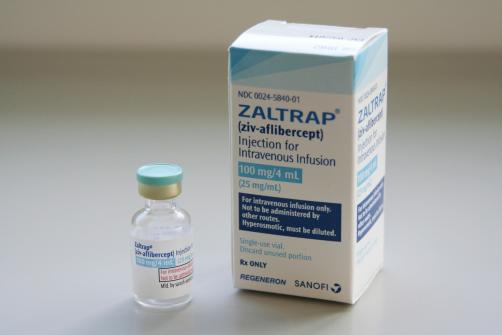A pair of studies by researchers at the Stanford University School of Medicine has identified a molecular pathway — a series of interaction among proteins — involved in the development of diabetes. Furthermore, they have found that a drug already approved for use in humans can regulate the pathway.
The findings will be published online Sept. 15 in two articles in Nature Medicine.
The studies, done in mice, identify a previously unexpected link between a low-oxygen condition called hypoxia and the ability of cells in the liver to respond to insulin. The drug, aflibercept (marketed as Eylea or Zaltrap), is used to treat metastatic colorectal cancer and a form of macular degeneration. Aflibercept is a member of a family of proteins that inhibit the vascular endothelial growth factor, or VEGF, pathway. It works by blocking the growth of the blood vessels into tumors and starving them of oxygen.
The lab of Calvin Kuo, MD, PhD, professor of medicine, identified a series of protein interactions that link VEGF inhibitors and blood glucose levels. “We were surprised to find that this drug currently used in patients for cancer treatment had beneficial effects on diabetes in laboratory mice and could, potentially, in humans,” said Kuo, senior author of one of the Nature Medicine papers.
Amato Giaccia, PhD, the Jack, Lulu and Sam Willson Professor of Cancer Biology, is senior author of the other paper. “Proteins involved in this pathway could also be targeted for the development of new diabetes therapies,” said Giaccia, who also is a professor and director of radiation oncology. His laboratory has identified a protein called PhD3 that could be a particularly attractive target.
The lead author of the Giaccia paper is Cullen Taniguchi MD, PhD, a radiation oncology resident at Stanford; former graduate students Kevin Wei, MD, PhD, and Lisa McGinnis, MD, PhD, and postdoctoral scholar Stephanie Piecewicz, PhD, are lead authors of the Kuo paper.
Together, the studies explain an observation made several years ago by Kuo and his lab members that VEGF inhibitors, such as aflibercept, could lower blood glucose levels in mice. There have been intriguing hints that these inhibitors could function in a similar way in humans, but human studies have not been formally conducted.
“Anecdotally, there have been reports that diabetic patients who have been prescribed VEGF inhibitors to treat their cancer are better able to control their diabetes,” Kuo said.
The liver is commonly known as the organ responsible for removing toxins from our blood. But it also serves as the body’s energy warehouse. After a meal, blood glucose levels rise and insulin triggers cells in the liver to squirrel away the glucose in long, branching chains of a substance called glycogen (imagine an ever-growing Lego structure, where each block is a glucose molecule). When we are asleep or fasting, the liver breaks down that Lego structure unit by unit to deliver glucose into the blood for cells to use as an energy source until the next meal.
When this process goes awry, blood glucose levels can become dangerously high. This can happen when the body either can’t make insulin (in the case of type-1, or juvenile, diabetes) or when it can’t respond appropriately to the insulin the body does make (type-2 diabetes).
The liver’s critical function requires that most of its cells have ready access to blood, which carries both glucose and oxygen. Oxygen diffuses as a gradient outward from blood vessels; those cells that are more removed have less oxygen and can become hypoxic. Hypoxic cells naturally produce certain proteins to enable them to live and function under these more severe conditions.
Wei, McGinnis and Piecewicz, in Kuo’s lab, found that one protein induced by hypoxia, HIF-2alpha, activates the expression of insulin receptor substrate 2. IRS2 enhances the ability of the cells to respond to insulin. Treatment of normal and diabetic laboratory mice with a variety of VEGF inhibitors, including aflibercept, causes regression of blood vessels and increases the number of hypoxic cells in the liver. As a result, HIF-2alpha levels increase, IRS2 expression rises and the animals become better able to tolerate increases in blood-glucose levels.
The researchers found that deletion of HIF-2alpha blocked the effect of the VEGF inhibitors, while liver-specific induction of HIF-2alpha expression also significantly improved the animals’ glucose tolerance.
“Much work remains to translate these mouse studies to human patients, but it will be interesting to explore VEGF inhibitors or drugs that can stabilize HIF-2alpha, such as prolyl hydroxylase inhibitors, for diabetes treatment, possibly in combination with pre-existing therapies to minimize toxicities,” Kuo said.
Taniguchi, in Giaccia’s lab, focused on the biology of HIF-2alpha. He and his colleagues found that blocking the expression of a protein called Phd3 specifically taps into the pathway identified by the Kuo group, stabilizing the HIF-2alpha protein and prolonging its effect on IRS2 expression. Laboratory mice missing Phd3 are more sensitive to insulin and exhibit improved glucose tolerance.
The specificity of the effect of Phd3 on HIF-2alpha is important. Because it doesn’t appear to regulate other proteins in the HIF family in the liver, it’s possible a diabetes treatment could be designed that would avoid unwanted or dangerous side effects that could occur by blocking the production of a more broadly acting protein.
“Targeting the Phd3/HIF-2 pathway represents a new therapeutic approach for the treatment of diabetes with little toxicity,” said Giaccia. “These studies indicate that Phd specific inhibitors, especially Phd3, should be more widely developed for clinical development.”


